YOSEMITE CONSERVANCY

Preserving Yosemite’s History & Culture
INSIDE
Preserving the JMT for Future Hikers
Honoring American-Indian History
Expert Insights on the History of Buffalo Soldiers
Q&A with Yosemite’s Program Manager for Cultural Resources
AUTUMN.WINTER 2018 :: VOLUME 09.ISSUE 02
YOSEMITE CONSERVANCY COUNCIL MEMBERS
CHAIR
Bob Bennitt*
VICE CHAIR
Dana Dornsife*
COUNCIL
Hollis & Matt Adams*
Jeanne & Michael Adams
Gretchen Augustyn
Jenny Augustyn & Ali Meghdadi
Suzy & Bob Bennitt*
David Bowman & Gloria Miller
Marilyn & Allan Brown
Steve & Diane Ciesinski*
Kira & Craig Cooper
Hal Cranston & Vicki Baker
Carol & Manny Diaz
Leslie & John Dorman*
Dave* & Dana Dornsife*
Lisa & Craig Elliott
Jewell & Bob Engstrom
Kathy Fairbanks
Sandra & Bernard Fischbach
Cynthia & Bill Floyd*
Jim Freedman & Karine Joret
Susan & Don Fuhrer*
Bonnie Gregory
Rusty Gregory*
Karen & Steve Hanson
Laura Hattendorf & Andy Kau
Chuck & Christy Holloway
PRESIDENT & CEO
Frank Dean*
VICE PRESIDENT, CFO & COO
Jerry Edelbrock
Christina Hurn & Richard Tassone
Jennifer & Gregory Johnson
Walt Lemmermann
Melody & Bob Lind
Sam & Cindy Livermore
Steve Lockhart & Karen Bals
Anahita & Jim Lovelace
Mark Marion & Sheila Grether-Marion
Patsy & Tim Marshall
Kirsten & Dan Miks
Robyn & Joe Miller
Kate & Ryan Myers
Janet Napolitano
Dick Otter & Judy Wilbur
Sharon & Phil Pillsbury*
Gisele & Lawson Rankin
Bill Reller
Pam & Rod Rempt*
Frankie & Skip Rhodes*
Liz Robbins
Dave Rossetti & Jan Avent*
Lisa & Greg Stanger*
Jennifer & Russ Stanton*
Ann* & George Sundby
Clifford J. Walker*
Wally Wallner* & Jill Appenzeller
Jack Walston & Sue Estes
YOSEMITE NATIONAL PARK
Superintendent Michael Reynolds
*Indicates Board of Trustees
OUR MISSION
Yosemite Conservancy inspires people to support projects and programs that preserve Yosemite and enrich the visitor experience.
PRESIDENT’S NOTE

Travel Back in Time
osemite is renowned for its spectacular scenery, but that’s not the only thing that makes it a special place. For thousands of years, human stories have taken shape alongside granite cliffs and giant sequoias.
In this issue, we look at how people throughout history, including Yosemite’s native residents, early conservationists, and modern-day rangers and researchers, have played a part in preserving one of the world’s greatest natural wonders.
These stories trace the roots of the John Muir Trail, delve into ranger Shelton Johnson’s dedication to sharing the tales of Buffalo Soldiers, and explore how Yosemite’s traditionally associated tribes worked with the park on a landmark project to protect a place deeply connected to American-Indian history.
You’ll also get a glimpse of the vast historical resources preserved by the Yosemite Museum, which was built in the 1920s with support from the Conservancy’s predecessor — one of the first acts of philanthropy in a national park. Thanks to you, the Conservancy continues to support projects that improve access to the museum’s collections while protecting historical images and artifacts.
The human experience in Yosemite can be just as powerful as the park’s incomparable grandeur. The memories we build in the park – from a first view of the Valley, to a favorite family hike in the high country – inspire us to care for and preserve this place.
By supporting Yosemite today, you are part of the park’s story. Thank you for your generosity, and enjoy this time-traveling look at your favorite park!
COVER PHOTO Every inch of Yosemite is steeped in natural and human history, from the soaring summit of Clouds Rest (pictured), to the shores of
and the historic
Frank Dean, President
Connect with us online!
Donors’ gifts have helped preserve places and stories tied to the park’s past. PHOTO: © KARYN O’HEARN.
Follow Yosemite Conservancy, and stay connected.
02 AUTUMN.WINTER 2018 PHOTO: (OPPOSITE) © YOSEMITE CONSERVANCY/KEITH WALKLET.
Tenaya Lake
John Muir Trail.

CONTENTS
AUTUM.WINTER 2018 VOLUME 09.ISSUE 02
IN THIS ISSUE DEPARTMENTS



04 RESTORING THE JOHN MUIR TRAIL
Learn about Muir’s legacy of conservation in Yosemite, and how his influence inspires modern-day restoration of the park’s iconic hiking trails.
08 A RESTORATION ROOTED IN TRADITIONS OF STEWARDSHIP
Travel back in time to see how Yosemite’s early inhabitants – American Indians –served as the original guardians of the park, and see how their legacy is being honored in current preservation projects.
10 A MODERN MOMENT FOR A HISTORIC MUSEUM
Preview art and artifacts from the new online exhibit that will bring Yosemite’s museum collections to global audiences.
12 EXPER T INSIGHTS
Park ranger and mounted patrol officer
Shelton Johnson shares an inside look at Yosemite’s legacy of Buffalo Soldiers.
14 Q&A WITH A YOSEMITE INSIDER
Scott Carpenter, program manager for cultural resources in Yosemite, explains how NPS experts preserve Yosemite’s history.
16 GRANT UPDATES
View vintage photos from Yosemite’s archives, learn how a trail restoration is restoring access to Yosemite history in Wawona, and more.
20 PROGRAM UPDATES
Adventure into the past, as our expert naturalists bring history to life in Yosemite Wilderness and honor the legacy of art.
22 ANNU AL REPORT EXCERPT
See the impact of your gifts in Yosemite.
26 WHY I GIVE
Conservancy donors share their stories of inspiration and passion.
30 READER PHOTOS
Yosemite Conservancy supporters share their special Yosemite memories.
YOSEMITECONSERVANCY.ORG 03
ABOVE The John Muir Trail treats hikers to stunning views of the same Sierra Nevada scenery that captivated Muir more than 100 years ago.

Sierra Saunter THE ULTIMATE
PRESERVING THE JOHN MUIR TRAIL FOR FUTURE ADVENTURERS


n March 1868, a young man with a strong Scottish accent stepped off a ship at a San Francisco pier. He asked a stranger for directions out of town.
“Where do you want to go?” the stranger asked.
“To any place that is wild.”
Thus began John Muir’s 310-mile, two-month walk to the Sierra Nevada, the first of many visits to the place that would, thanks in large part to Muir’s influence, become Yosemite National Park.
The year after his ramble to Yosemite, Muir spent his famous “first summer in the Sierra”; in the ensuing decades, he explored, studied and fought for wild places throughout the West.
Though he passed away more than a century ago, John Muir lives on through his legacy: in his informal title, “Father of the National Parks”; in the Sierra Club, which he helped co-found in 1892; and in the many places that bear his name, such as California’s Muir Woods, Alaska’s Muir Glacier and Scotland’s John Muir Way.
In addition to playing a key role in the creation of numerous national parks, including Yosemite, Mount Rainier and the Grand Canyon, Muir promoted
YOSEMITECONSERVANCY.ORG 05 PHOTOS: (LEFT) © YOSEMITE CONSERVANCY/KEITH WALKLET. (ABOVE) © JOHN MUIR PAPERS, HOLT-ATHERTON SP.
LEFT Donors’ support has helped restore sections of the John Muir Trail, a popular backpacking and hiking route that honors the legacy of its famous namesake.
UPPER CATHEDRAL MEADOW
Restoration crews relocated a stretch of the JMT out of wetland habitat to ensure the long-term health of the meadow and trail.


YOSEMITE VALLEY
Sections of the JMT have been resurfaced with sustainable tread to improve the hiking terrain and make the trail more resilient.
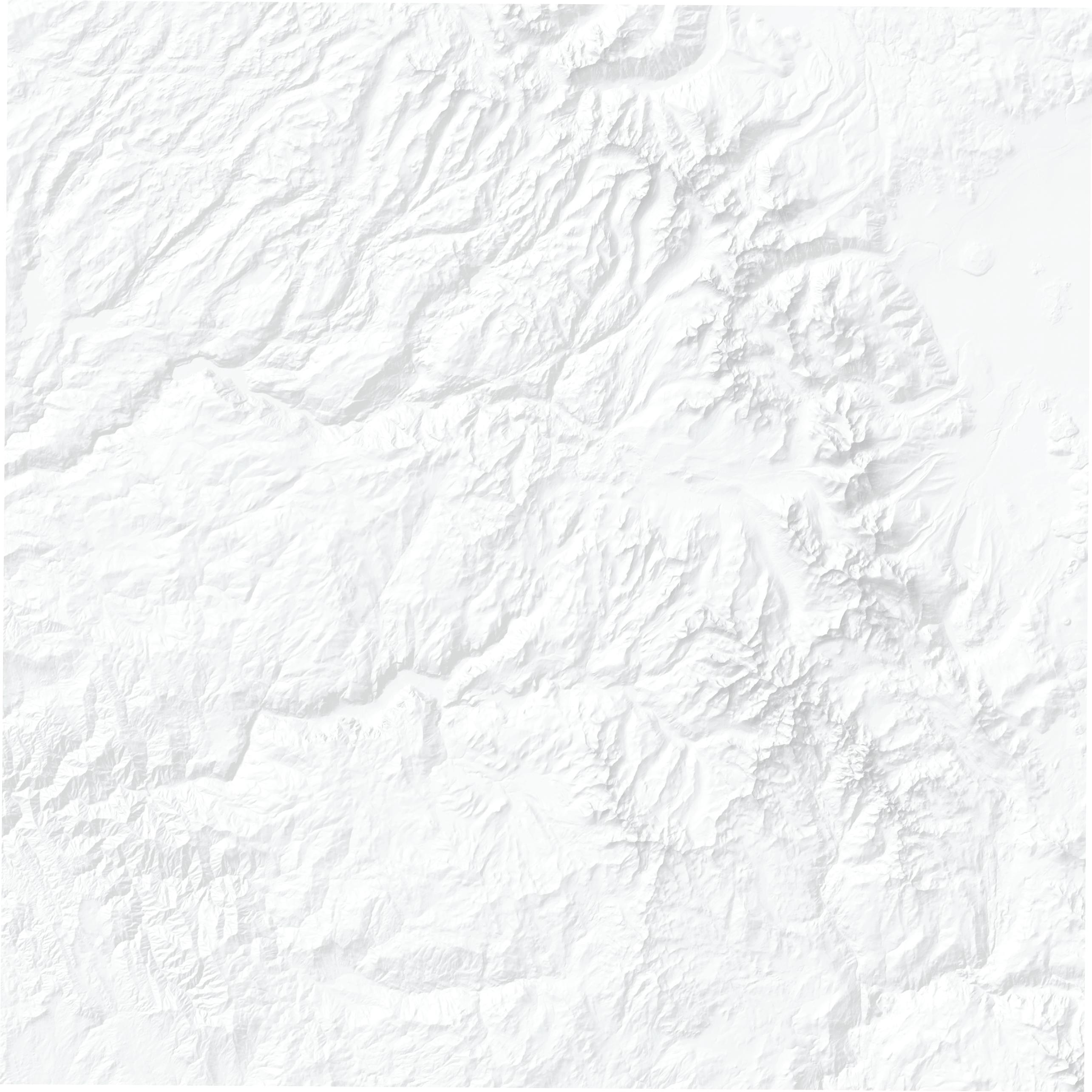
hiking trails — or sauntering trails, as he might have said, preferring reverent wandering to fast-paced trekking — as a way to help people reconnect with the natural world.
In Yosemite, you’ll see Muir’s name on signs pointing the way to the John Muir Trail (JMT), the 210-mile route that connects Yosemite Valley and Mount Whitney. Every year, thousands follow that famous trail, which leads to destinations such as Vernal Fall, Half Dome and Cathedral Peak.
As the story goes, what is now the JMT was first dreamed up in 1884 by 14-year-old Theodore Solomons, who would grow up to be an accomplished explorer and naturalist. A plan for the long-distance trail along the spine of Muir’s “Range of Light” took shape over decades, as geologists, geographers and adventurers explored peaks and passes. Originally proposed as the “High Sierra Trail,” the route was renamed in Muir’s honor after his death in 1914 and was completed in 1938, 100 years after his birth.
JOHN MUIR TRAIL Donor-Funded Improvements to the
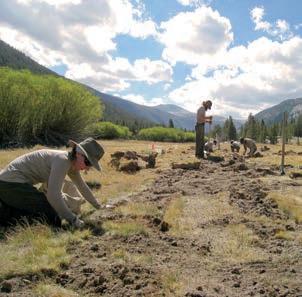
LYELL CANYON
Repairing ruts and shifting the trail to dry terrain has helped to protect the meadow ecosystem and create a more enjoyable hiking experience.
Since then, countless people have set foot on the JMT, whether for half-day jaunts, through-hikes to cover the full 210 miles, or even longer expeditions on the 2,663-mile, 50-year-old Pacific Crest Trail, which overlaps with the JMT for about 160 miles, including in Yosemite’s Lyell Canyon.
All those footsteps mean that eight decades worth of wilderness-wanderers have had a chance to experience the forests, meadows and mountains that captured Muir’s heart — but they also result in heavy, sometimes detrimental impacts on the aging trail. Over the years, Conservancy donors have funded numerous projects to repair and protect the JMT for future generations of hikers.
As you follow the JMT from its starting point at Happy Isles in Yosemite Valley, look for restored steps and smooth sections resurfaced with sustainable, selfhealing material; in late spring, you might encounter donor-supported California Conservation Corps crews
06 AUTUMN.WINTER 2018
PHOTOS: (TOP) © YOSEMITE CONSERVANCY/KEITH WALKLET. (MIDDLE & BOTTOM) © COURTESY OF NPS.
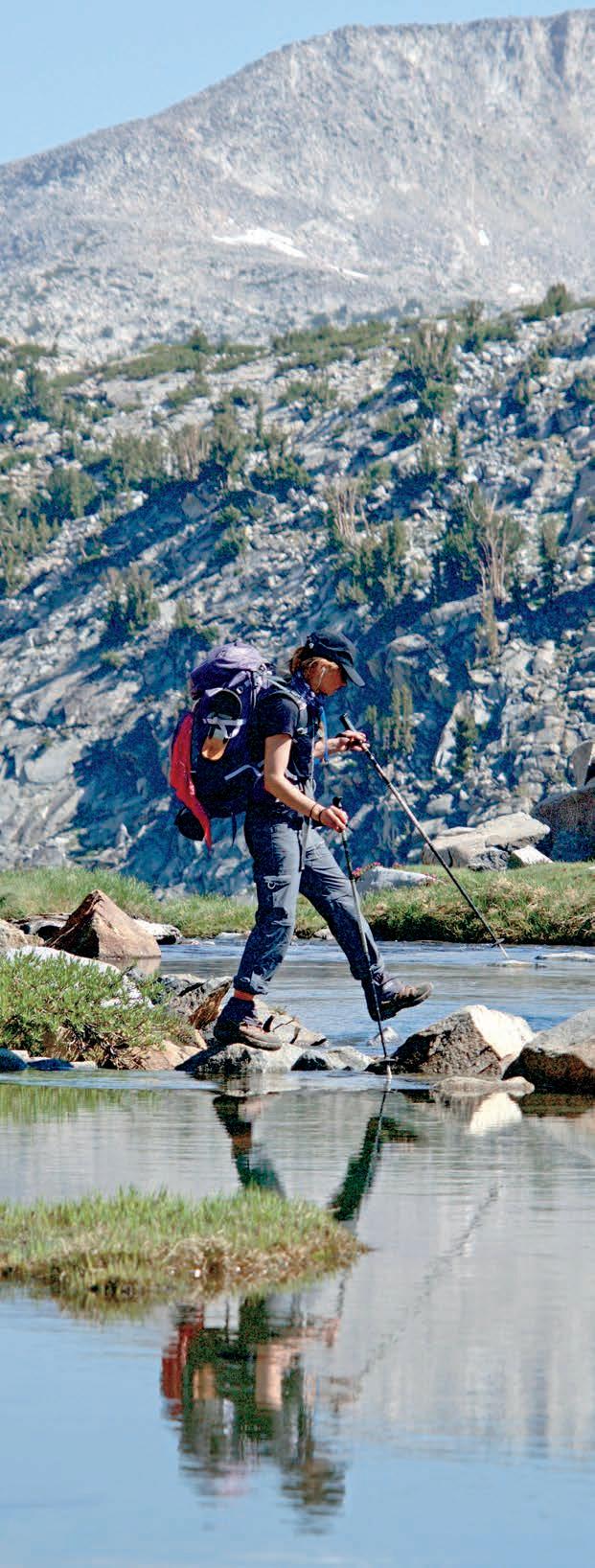
preparing the trail for the busy summer season, before they head into the backcountry.
In the high country, you’ll see evidence of donor-funded work near Upper Cathedral Lake, where crews shifted a 0.4-mile stretch of the JMT to more durable ground in 2010. Originally, the rutted trail bisected the lakeside meadow, cutting off water flow; now, hikers follow the JMT through a lodgepole pine forest, enjoying Muir’s unmatched “repose … of the deep green woods” while leaving the wetland untrammeled.
Similar work is under way in Lyell Canyon, near the park’s eastern border, where hikers, horses and mules have forged deep furrows in the soil by stepping off the JMT into adjacent meadow to avoid mud and water. By building more than two miles of new trail segments on nearby dry, drainable terrain, and then loosening and replanting the meadow, crews are ensuring the long-term health of the JMT and the ecosystem.
John Muir never got to saunter on the completed trail that bears his name, but his spirit endures in the people who travel and tend to it today — and in supporters such as you, who ensure present-day adventurers can, in his words, “keep close to nature’s heart” among the pines, peaks and sun-drenched passes of the Range of Light.

YOSEMITECONSERVANCY.ORG 07 PHOTOS: (LEFT) © DAMON CORSO. (ABOVE) © MISTI WEBSTER.
LEFT A JMT backpacker crosses the Lyell Fork of the Tuolumne River near Donohue Pass, where the trail enters Yosemite. ABOVE Farther downstream, a backpacker follows the JMT through Lyell Canyon, where donor-funded restoration crews have rerouted the trail in order to protect precious wetlands.

HONORING AMERICAN-INDIAN HISTORY IN MARIPOSA GROVE

A restoration rooted in traditions of stewardship
n a typical Yosemite timeline, the Mariposa Grove of Giant Sequoias might first appear in 1864, with Lincoln’s Yosemite Grant Act, but its history as a cherished place goes back much further.
For thousands of years, American Indians made their homes in the Sierra, including on the snow-fed western slopes where sequoias thrive. Some traveled through or lived in the meadows by Mariposa Grove, and watched for weather changes and wildlife from nearby promontories.
In Wawona and beyond, American Indians drew on Traditional Ecological Knowledge (TEK), a living collection of practices and beliefs rooted in respect for nature. They gathered plants for medicine, tools and baskets; revitalized forests using low-intensity fires; and promoted biodiversity, guided by the principle that all life should be able to thrive.
ABOVE Boardwalks, flourishing wetlands and sustainable trails are all evidence of the restoration of Mariposa Grove, which brought together the National Park Service, the Conservancy and Yosemite-area tribes in a collaborative effort to protect the sequoia ecosystem and honor American-Indian history.
08 AUTUMN.WINTER 2018
Today, the traditionally associated tribes (Mono Lake Kutzadikaa Tribe, Bishop Paiute Tribe, Southern Sierra Miwuk Nation, Picayune Rancheria of Chukchansi Indians, Bridgeport Indian Colony, North Fork Rancheria of Mono Indians of California, and Tuolumne Band of Me-Wuk Indians) retain their connection to the grove as its original stewards.
The landscape their ancestors moved through and cared for over millennia, however, changed dramatically in the 19th and 20th centuries. In 1851, the Mariposa Battalion captured American Indians camped near the sequoias, as part of a campaign to force native residents onto reservations. Galen Clark, known today as the inaugural guardian of the Yosemite Grant, paid his first visit to the grove in 1855.
As word of the grove spread, tourists flowed in. A century and a half later, the giant sequoias were still standing, but tribal stewardship ethics had been overshadowed by development. Paved roads had replaced trails. Buildings had sprung up over sequoia roots. Wetlands were buried or fragmented.
Change sprouted again in 2012, when representatives from the associated tribes began working with the National Park Service and Yosemite Conservancy to restore the grove, preserve its natural beauty, and honor the extensive, intricate human history entwined with the trees.
Reba Fuller, of the Tuolumne Band of Me-Wuk Indians, says tribal representatives were eager to join the muchneeded restoration, the first park project to involve all seven

tribes working with each other and the NPS. She recalls a collaborative process guided by a shared goal: to create a welcoming, educational space honoring “native people, historical events and what sustains a healthy environment.”
“We recognized a common value,” Fuller says. “We are stewards of the land, just like the people of yesteryear.”
When you visit the grove today, you’ll see evidence of the tribes’ deep involvement in the restoration and continued connection to the area. Tribal members provided feedback on conceptual designs, helped determine routes for new trails tracing age-old footpaths, and developed interpretive panels offering historical context, ecological insights and traditional stories. As one sign explains, American Indians have helped reintroduce controlled, low-intensity fires to Mariposa Grove and other locations, an example of TEK informing modern management.
On June 14, 2018, a few months after leading a songfilled celebration among the sequoias, tribal representatives offered a blessing at the dedication ceremony for the grove, which reopened to the public the following morning.
Mariposa Grove holds a storied place in public-lands history, but the restoration wasn’t just about celebrating the sequoias’ role in the national park idea. The project also pays tribute to people who, over generations, watched today’s oldest sequoias grow into giants — and ensures they can maintain a strong connection to the grove in the future.
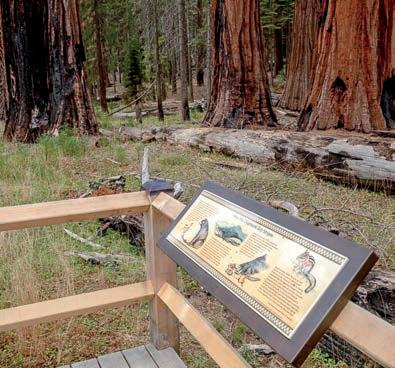
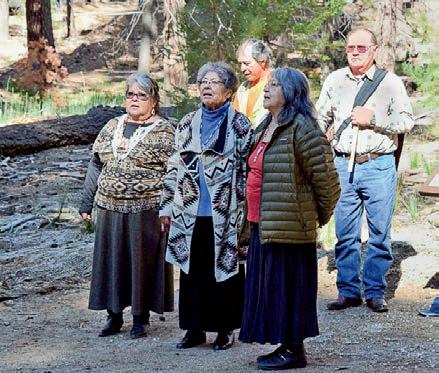
YOSEMITECONSERVANCY.ORG 09 PHOTOS: (OPPOSITE) © YOSEMITE CONSERVANCY/JOSH HELLING. (BOTTOM LEFT TO RIGHT) © MICHAEL WHITE. © YOSEMITE CONSERVANCY/KEITH WALKLET. © COURTESY OF NPS.
LEFT American Indians lived in and around Yosemite long before Mariposa Grove’s famous Grizzly Giant, which is an estimated 1,800 years old, took root. MIDDLE New interpretive signs throughout the grove, including this illustrated story of “How the Chipmunk Got Stripes,” help visitors connect with the people who lived in and around Yosemite for millennia. RIGHT American-Indian tribal representatives joined the NPS and the Conservancy for a special song-filled ceremony in Mariposa Grove in October 2017.
A Modern Moment for a Historic Museum
he Yosemite Museum started with two “firsts”: It was the first National Park Service structure built as a museum, and it was constructed with support from the first NPS cooperating association — which lives on as Yosemite Conservancy.
Since its opening in 1926, the museum’s collection has grown to more than 5.5 million artifacts, specimens and documents. A donorfunded project is expanding access to those resources through another first: the museum’s inaugural web-based exhibit with the Google Cultural Institute, a nonprofit that “brings the world’s cultural heritage online.”
Enjoy this preview of some of the objects featured in the exhibit, launching in December.

This factually flawed sign touted the wonders of Mariposa Grove’s Grizzly Giant. While neither the oldest nor largest in the world, the famous sequoia has lived an impressive 1,800 years.
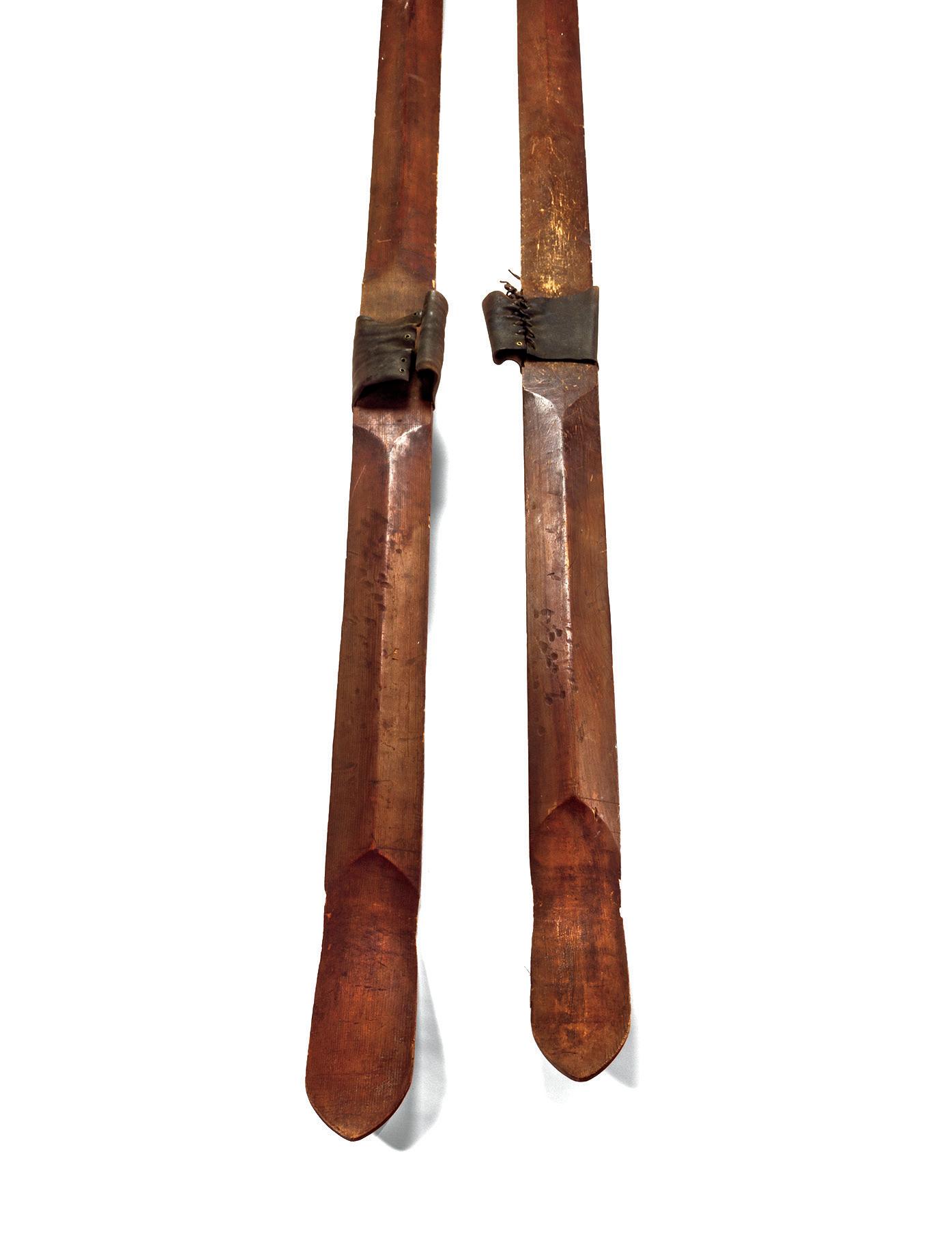
These handmade wooden skis are thought to have been used by Tom Hutchings, an American Indian who carried winter mail and supplies into the Valley in the late 1800s.
baskets have long been a staple of American-Indian culture in Yosemite. The museum collection includes numerous traditional baskets, including intricate 20th-century pieces created by renowned weavers, such as Mary Wilson and Lucy Telles.


10 AUTUMN.WINTER 2018
AMERICAN-INDIAN
Woven
BASKETS
WOODEN SKIS
PHOTOS: © MARY WILSON, COURTESY OF YOSEMITE MUSEUM, YOSE 31691. © LUCY TELLES, COURTESY OF YOSEMITE MUSEUM, YOSE 237671.
GRIZZLY GIANT SIGN
PHOTO: © COURTESY OF YOSEMITE MUSEUM, YOSE 5430 AND 6288.
PHOTO: © COURTESY OF YOSEMITE MUSEUM, YOSE 21864.


After spearheading a campaign to donate Tioga Road to Yosemite in 1915, Stephen Mather dedicated the newly public thoroughfare by smashing a bottle over this rock painted with the purchase price.


Yosemite’s American Indians used cradle baskets, or cradleboards, to carry infants. This one, crafted mainly from willow in the 1930s, features a sunshade, wooden footrest, deerskin cover and decorative beadwork.
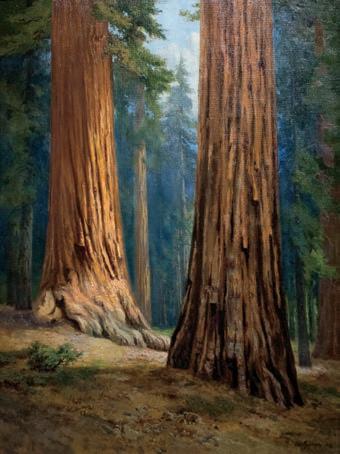
After building a studio in Yosemite Valley in 1900, Chris Jorgensen used watercolor and oil paints to capture the park’s beauty, as in this 1910 depiction of Mariposa Grove.
Thomas Ayres’ sketches, including this 1856 piece featuring Vernal Fall, were the first known drawings of Yosemit. They helped publicize the Valley’s beauty in the mid-19th century.
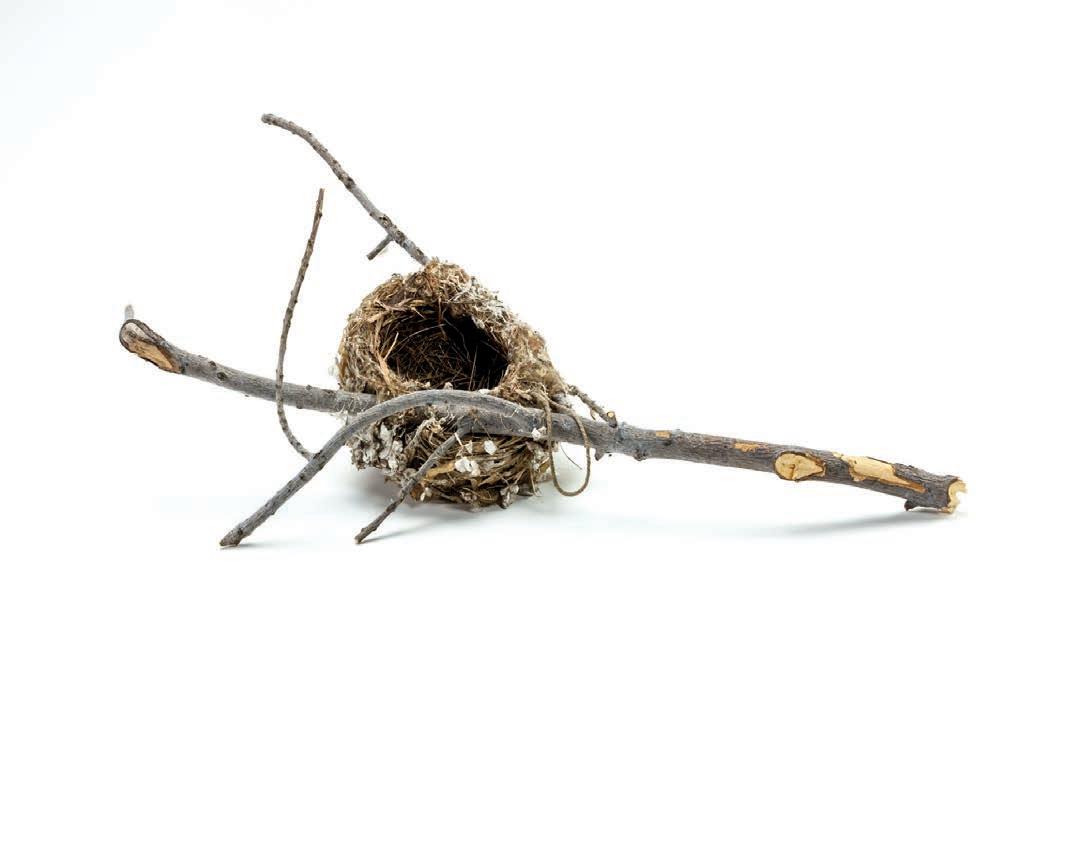
In addition to artwork and cultural artifacts, the Yosemite Museum houses numerous natural specimens, such as this well-preserved Pacificslope flycatcher nest, which was collected in the Valley in 1936.
YOSEMITECONSERVANCY.ORG 11
THOMAS AYRES
CRADLE BASKET
TIOGA ROAD CAMPAIGN
FLYCATCHER NEST
CHRIS JORGENSEN
PHOTO: © COURTESY OF YOSEMITE MUSEUM, YOSE 5225.
PHOTO: © COURTESY OF YOSEMITE MUSEUM, YOSE 066729.
PHOTO: © CHRIS JORGENSEN, COURTESY OF YOSEMITE MUSEUM, YOSE 7883.
PHOTO: © COURTESY OF YOSEMITE MUSEUM, YOSE 23384.
PHOTO: © THOMAS AYRES, COURTESY OF YOSEMITE MUSEUM, YOSE 2101.

LEFT Ranger Shelton Johnson is deeply dedicated to studying and sharing the stories of the African-American “Buffalo Soldiers,” who served as early nationalpark guardians. MIDDLE Yosemite’s modern mounted patrol program has roots in the late 1800s and early 1900s, when African-American cavalrymen played a key role in Yosemite and other national parks.
YOSEMITE’S FIRST RANGERS

THE HISTORY OF BUFFALO SOLDIERS
BY SHELTON JOHNSON, MOUNTED PATROL
graduated from Yosemite’s Horse Patrol School in 1996, having an unshakable desire to learn what it once meant to be a cavalryman for the U.S. Army, like the Buffalo Soldiers who served in the park more than a century ago.
In the aftermath of the Civil War, the U.S. Congress created six regiments of African-American enlisted soldiers, two of which became known as the “Buffalo Soldiers.” Well before the establishment of the National Park Service, these cavalry units helped fill the role of a “small, reliable police force” within our country’s first national park, Yellowstone. The Buffalo Soldiers later expanded to Yosemite and Sequoia national parks, where they built and improved trails and roads, extinguished fires, expelled poachers and timber thieves, and patrolled the wilderness.
In Yosemite, horses helped soldiers navigate a park that, at the time, covered 1,500
12 AUTUMN.WINTER 2018
RANGER, YOSEMITE NATIONAL PARK
EXPERT INSIGHTS

square miles of rough terrain, with few trails or roads. The cavalrymen could draw on their equestrian expertise — and 1,000-pound mounts — to create an atmosphere of law and order. Throughout the 20th century and into today, park rangers carry on this tradition by patrolling Yosemite’s high country.
On July 4, 1970, the famous Stoneman Meadow Riot ended with an altercation between rangers and visitors. Raising important questions about visitor access and interactions, the event underscored the fact that mounted park rangers needed additional training, similar to traditional cavalry training. Riding a horse is one skill set; controlling that horse during conflict and using it to quell aggression is another entirely.
Stoneman Meadow, however, is not a battlefield. Nor are any
“In this work, however, they were allowed to be human beings and given the freedom to become giants.”

of the other places today’s rangers patrol in the park. Like the Buffalo Soldiers, modern-day rangers don’t use horses as weapons; they work in partnership with their animals to maintain order, protect resources and keep people safe. That partnership between rangers and horses is based on respect for the animal — and for the long tradition that ties us to the saddle.
For the cavalrymen, serving in Yosemite was easy, compared with open warfare, but it was not without challenges. After all, they were still African-American men fighting for survival in the decades after the Civil War, still the sons of sharecroppers and grandsons of formerly enslaved people, still the Buffalo Soldiers. In this work, however, they were allowed to be human beings and given the freedom to become giants.
YOSEMITECONSERVANCY.ORG 13
EXPERT INSIGHTS
PHOTOS: (LEFT) © AL GOLUB. (MIDDLE) © U.S. ARMY MILITARY HISTORY INSTITUTE (PRESIDO). (RIGHT) © COURTESY OF NPS.
RIGHT Buffalo Soldiers relied on horses to traverse rugged terrain and instill “law and order” in Yosemite. Today, mounted patrol rangers continue to work with horses to keep visitors and park resources safe.
“Support from Conservancy donors has played a critical role in so many important cultural preservation projects.”
— SCOTT CARPENTER
Yosemite’s Program Manager for Cultural Resources
Q&A
WITH A YOSEMITE INSIDER

ired as Yosemite’s first full-time archeologist in 1981, Scott Carpenter was tasked with the exciting challenge of developing and operating Yosemite’s emerging cultural resources program. Fast forward to today, and Carpenter oversees Yosemite’s cultural resources program, which includes archeology, anthropology, cultural engagement, history and historic architecture — both human-made and of the landscape. His work is fueled by his deep curiosity about Yosemite’s past and passion for problemsolving. Carpenter shares, “There’s never a dull moment in Yosemite.”
Q :: What does your job as program manager for cultural resources in Yosemite National Park entail?
A :: Our team is responsible for the documentation, research, evaluations and management of all cultural resources from 9,000-year-old archeological sites, ethnographic areas, historic sites and buildings, historic roads and trails, landscapes, and related features. Our tribal liaison staff actively coordinates the consultation with members of the seven traditionally associated American-Indian tribes and groups to Yosemite.
Q :: Why do Yosemite’s cultural resources need to be preserved?
A :: Yosemite’s cultural resources include archeological sites, traditional cultural areas and resources important to modern tribes, historic buildings, landscapes, artifacts and museum collections. Examples of cultural resources include the historic Ahwahnee (Majestic) Hotel, a 4,000-year-old prehistoric campsite, Tioga Road, a Thomas Hill painting and recorded oral history. None of these cultural resources has more importance than another. Of more importance is the context of all cultural resources — including place, purpose and relationship — throughout Yosemite’s varied landscape. It is this context that helps tell the story of human history in Yosemite.
Q :: What methods do you use to preserve and protect cultural resources in Yosemite?
A
:: We begin with careful surveys and inventories to discover and document the location and makeup of each cultural resource. Our techniques include archeological, ethnohistorical and historical research; mapping, soil and geologic studies; and vegetation and wildlife studies used to better understand the context of a site or structure. After the initial studies, we then revisit known sites on a periodic basis to monitor their condition and any threats to their preservation. Our team also works with park planners, designers and facilities managers to preserve important sites by planning new development to avoid significant resources.
14 AUTUMN.WINTER 2018
ABOVE Ranger Scott Carpenter oversees Yosemite’s cultural resources, including archeological sites, historic buildings and trails, and museum collections.
Q :: How have — or can — Conservancy donors help protect Yosemite’s cultural resources?
A :: Support from Conservancy donors has played a critical role in so many important cultural preservation projects. From the construction of the traditional roundhouse at Wahhoga, to the preservation of important museum collections and tribal youth intern projects to train future researchers and resource stewards, the most important thing Conservancy donors can do to help protect Yosemite’s cultural resources is to promote and pass on the message that Yosemite’s cultural resources are unique and irreplaceable resources. Once an artifact is separated from an archeological site or a historic building is lost due to disrepair, vital pieces of the cultural heritage of the park are lost forever.
“It is this context that helps tell the story of human history in Yosemite.”


Share your love for Yosemite this holiday season with a gift from the Yosemite Conservancy bookstore. Every purchase helps us preserve and protect Yosemite for generations to come. Conservancy donors receive a 15% discount with code HOLIDAY2018* *Code valid through Jan. 31, 2019; online purchases only. Shop now at yosemiteconservancy.org/shop
YOSEMITECONSERVANCY.ORG 15
ABOVE Yosemite’s collections contain thousands of historical artifacts, including antique instruments, notes penned more than a century ago, and a tin cup John Muir famously carried on his adventures in the park.
YOSEMITE INSIDER
PHOTOS: (OPPOSITE) © SCOTT CARPENTER. (RIGHT) © YOSEMITE CONSERVANCY/KEITH WALKLET
Give the Gift of Yosemite
PHOTOGRAPHIC MEMORIES
SAVING HISTORICAL IMAGES FROM THE YOSEMITE ARCHIVES

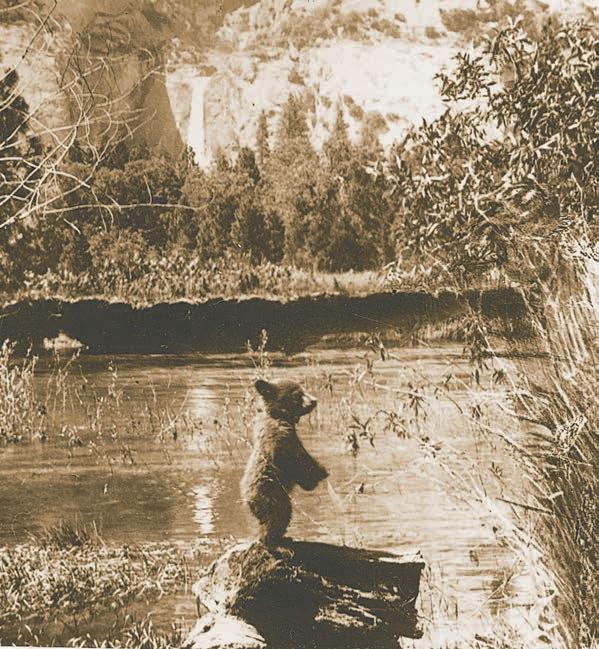
Historical photos show Yosemite’s human history, too, including early days of automobile-driven tourism in the Valley. RIGHT Student Conservation Association interns got hands-on experience with archival science, as they researched and digitized thousands of historical Yosemite photos, thanks to a 2018 donor-supported preservation project.
intage Yosemite photos offer signs of bygone eras: hikers in bloomers, horse-drawn carriages, people feeding bears. You might spot changes in the surroundings, too. Saplings captured in black and white now tower overhead, rock falls have reshaped cliffs, and glacial ice has retreated.
The Yosemite Research Library houses tens of thousands of mid-20th-century photographs that offer glimpses into the past and serve as a valuable resource for scientists, historians and other scholars. Although the original transparent negatives have been carefully stored, many are starting to deteriorate with age.
GRANT UPDATES 16 AUTUMN.WINTER 2018
LEFT Vintage images, such as this photo of a bear cub in Yosemite Valley, can transport viewers back to moments in the park’s past. MIDDLE

This year, undergraduate Student Conservation Association interns worked with library staff on a grant-funded project to preserve the images before time runs out. After researching the copyright status on scores of negatives, the interns created 6,600 high-resolution scans to add to NPGallery, a public resource for national park photos.
Some of the newly digitized photos show iconic features largely unchanged in the past century; others capture fleeting moments, such as an early auto tour of the Valley or World War II soldiers at Tunnel View. Now, thanks to you, those images are protected from further degradation and readily available to researchers — and to you!
See the photos at npgallery.nps.gov, and read the SCA interns’ “Insights from the Archives” on our blog at bit.ly/yosemite-archives.
“I hope the photos we are digitizing will help people realize the strides that have been made to preserve Yosemite and make visitor experiences more accessible, educational and sustainable.”
— OLIVIA SWARTHOUT
2018 SCA intern

Engaging the Next Generation Through Photography
As Student Conservation Association interns worked to preserve vintage photos this year, the donor-supported Parks in Focus program helped groups of middle school students explore the present-day park through the lens of digital photography.
Like generations of park visitors before them, both the interns and the adolescent adventurers had the chance to connect with Yosemite through photography. With your support, they preserved historical images and produced new ones, creating resources that can help more people, whether remote researchers or friends and family, learn about and find inspiration in Yosemite.
GRANT UPDATES YOSEMITECONSERVANCY.ORG 17
PHOTOS: (LEFT) © YOSEMITE RESEARCH LIBRARY, RL-018112. (ABOVE) © YOSEMITE RESEARCH LIBRARY, RL-015919. (RIGHT) © COURTESY OF NPS.
A TRAIL TO THE PAST
IMPROVING ACCESS TO HISTORY IN WAWONA

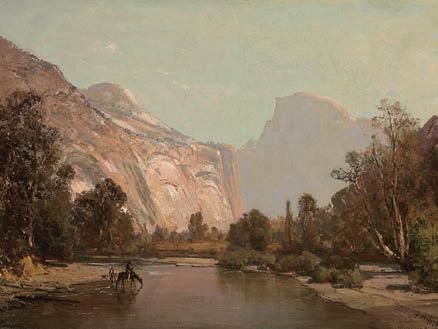
he Wawona area might be best known for Mariposa Grove, but it’s also a hub for historical structures.
Cross the covered bridge over the South Fork of the Merced River to the Pioneer Yosemite History Center, a collection of late 19th- and early 20th-century buildings, including a homesteader’s cabin, blacksmith shop and U.S. Cavalry office. Up the hill from the history center, you’ll find the 1884 studio of Thomas Hill, whose paintings of Sierra scenery helped popularize Yosemite and the push for its protection. Today, Hill’s studio hosts the Wawona Visitor Center and is part of a National Historic Landmark.
The studio and history center have been restored with donors’ support in recent years; in 2018, attention shifted to the uneven, off-putting steps linking the two sites. Thanks to your gifts, a smooth, sustainably surfaced new trail now offers a safer, more accessible route for visitors journeying into Yosemite’s past.
GRANT UPDATES 18 AUTUMN.WINTER 2018
ABOVE Artist Thomas Hill, whose studio is preserved as the Wawona Visitor Center, was famous for his paintings of Yosemite landscapes.
ABOVE With support from donors, park crews are transforming these steep steps between the Pioneer Yosemite History Center and the Wawona Visitor Center into a smooth, easy-to-navigate trail.
PHOTOS: (OPPOSITE) © COURTESY OF NPS. PHOTOS: (TOP) © COURTESY OF NPS. (BOTTOM) © WIKIMEDIA COMMONS/PUBLIC DOMAIN.


MUSTANGS ON PATROL
A NEW APPROACH TO A HISTORIC HORSE PROGRAM
ore than two decades before the National Park Service was established, cavalrymen served as Yosemite’s first rangers. Today, horses remain a core part of park operations, helping rangers patrol trails, carrying supplies and serving as beloved four-legged ambassadors.
Recent donor-funded grants to improve corrals, expand visitor education and bring in new horses have helped Yosemite’s equine legacy thrive. This year, your support helped the mounted patrol team tread new ground with the adoption of two mustangs trained by inmates at a California correctional facility, through an innovative Bureau of Land Management program. The mustangs, Drifter and Sandman, spent their first few months getting used to their new workspace (748,000 acres of forests, meadows and mountains), meeting their colleagues (horses, mules and rangers) and honing skills, such as navigating trails and meeting visitors.
Thanks to you, these newly minted mounted patrol members are strengthening a long-lived Yosemite tradition, while breaking new ground for the park’s equestrian team.
GRANT UPDATES YOSEMITECONSERVANCY.ORG 19
TOP Yosemite rangers are training adopted mustangs Drifter and Sandman to serve on the park’s mounted patrol team. BOTTOM The two mustangs are joining an equine tradition that dates back to Yosemite’s early years as a national park, when rangers depended on horses to move efficiently around the landscape.
ADVENTURING INTO THE PAST
NATURALISTS BRING HISTORY TO LIFE IN YOSEMITE

icture a history classroom. You probably conjure up desks, textbooks and a chalkboard covered in dates. Now picture an outdoor history classroom: one with granite walls, animal tracks, and ancient pictographs and pestles. In Yosemite, you’ll find eons of fascinating history to explore and experts who bring the past to life.
During day hikes, backpacking trips and evening programs, the naturalists who lead Conservancy Outdoor Adventures will take you back in time to see how American Indians lived in balance with the land for millennia, and how artists, pioneers and conservationists influenced Yosemite’s trajectory. You’ll learn how glaciers and rivers have sculpted the park, and how plants and animals have adapted to life in the Sierra.
You’ll also see how natural and cultural histories intersect: how giant sequoias inspired public lands legislation, how Valley cliffs shaped modern climbing, how human–bear relationships have evolved.
Whether you join a naturalist for a half-day in the Valley or a weekend in the high country, you’ll leave this outdoor classroom with a deeper understanding of the natural and human forces that have shaped Yosemite, and of how you can help steward the park for the future.
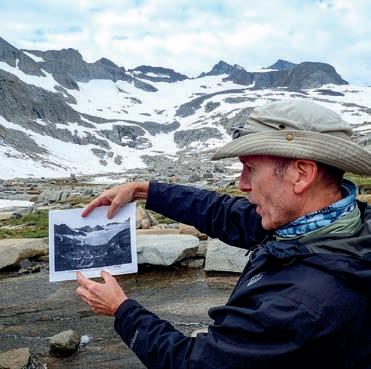
TOP Yosemite Conservancy’s naturalist guides share the natural and human history of iconic features such as Half Dome, from its geologic origins to its significance in AmericanIndian culture. BOTTOM The Conservancy’s resident naturalist, Pete Devine, leads annual backpacking trips to Mount Lyell, where participants learn about the past, present and future of Yosemite’s glacial ice.
Yosemite Conservancy offers expert-led Outdoor and Custom Adventures year-round.
Find your experience: yosemiteconservancy.org/ outdoor-adventures
PROGRAM UPDATES 20 AUTUMN.WINTER 2018
PHOTOS: (OPPOSITE) © ALBERT BIERSTADT, WIKIMEDIA COMMONS/PUBLIC DOMAIN. PHOTOS: (TOP) © YOSEMITE CONSERVANCY/KEITH WALKLET. (BOTTOM) © ROY WILLIAMS PHOTOGRAPHY.
YOSEMITE’S ARTISTIC LEGACY
AT HAPPY ISLES ART AND NATURE CENTER, HONORING A HISTORY OF ART IN THE PARK

n 1849, draftsperson Thomas Ayres arrived in California for the gold rush. He failed to find a fortune in the fields, but he earned fame for producing the first-known sketches of Yosemite Valley in 1855.
Within a few years, artwork was flowing from this newly publicized part of the Sierra. Albert Bierstadt, Thomas Hill, Carleton Watkins and others captured scenery on canvas and camera, producing pieces that propelled efforts to protect Yosemite and other public lands.
Today, amateur and professional artists, alike, continue to find inspiration in the park — including at Happy Isles Art and Nature Center in eastern Yosemite Valley, the new home of the Conservancy’s long-running art program.
For more than 35 years, our art workshops, often held en plein air, have encouraged people to slow down and see their surroundings through fresh eyes. Professional artists help participants capture the park’s natural splendor in workshops based at Happy Isles, an idyllic setting for a day of sketching, painting or mosaic-making.
Regardless of whether you’ve ever picked up a paintbrush, these workshops allow you to immerse in the enduring beauty that once enchanted artists such as Ayres and Bierstadt, as you join a long legacy of park-inspired art.
HAPPY ISLES ART & NATURE CENTER: THE BASICS
WHO: Anyone! No experience necessary.
WHAT: Art workshops, dropin studio and gallery, summer kids’ classes and activities.
WHERE: East end of Yosemite Valley (shuttle stop No. 16).
WHEN: Open April–October, with workshops Monday–Saturday.
WHY: Get a fresh perspective on your park, and create your own masterpiece!
HOW: Browse and register for workshops at yosemiteconservancy.org/art.
PROGRAM UPDATES YOSEMITECONSERVANCY.ORG 21
ABOVE Artists such as Albert Bierstadt, who created this oil painting of the Valley in 1864, helped publicize Yosemite’s beauty and inspire the legislation that protected it.

2017 Annual Report
CHAIR & PRESIDENT’S NOTE
Dear Friend of Yosemite:
n this fast-paced age, Yosemite can feel like a timeless haven. When you place your hand on ancient rock, sit by a lake left by long-ago glaciers, or gaze up at thousand-year-old giant sequoias in newly restored Mariposa Grove, you can’t help but slow down.
Yosemite always inspires us to pause and reflect — and we’re grateful for this opportunity to reflect on how supporters such as you play a central role in preserving this enduring place. Last year, with your help, we provided $11 million in total aid to Yosemite, through a combination of 39 new grants, high-quality visitor programs, volunteer efforts and more.
Some of the work you made possible in 2017 is highly visible: the new Washburn Trail taking shape near the South Entrance, newly planted pollinator-friendly flowers blooming in Yosemite Valley, kids sporting hard-earned Junior Ranger badges, and sturdy new canvas tents to house the Search and Rescue team in Camp 4.
In other cases, your support took shape in less traveled parts of the park, sending scientists to moonlit forests or remote peaks to observe rare owls and bighorn sheep; helping crews restore meadows, trails and lakeshores deep in the Yosemite Wilderness; and giving American-Indian students the chance to work with archeologists while unearthing ancient stories in the backcountry.
And, sometimes, your support produced intangible but invaluable results, by inspiring people to explore and care about the natural world. Young people gained experience that could lead them to public lands careers, climbers learned about protecting the vertical wilderness, our 30 weeks of art classes helped people see Yosemite’s beauty in a new way, and thousands of visitors honed Leave No Trace skills during our 225 expert-led adventures.
Your support makes Yosemite more resilient today and ensures it will shine as a jewel in our national park system for years to come.
 Bob Bennit, Chair Frank Dean, President
Bob Bennit, Chair Frank Dean, President
Please enjoy highlights of our 2017 Annual Report. The full-length report can be viewed on our website at yosemiteconservancy.org/annual-reports.
PHOTO: (LEFT) © YOSEMITE CONSERVANCY/JENNIFER MILLER. PHOTOS OPPOSITE (TOP RIGHT & MIDDLE LEFT) © COURTESY OF NPS. (MIDDLE RIGHT) © COURTESY OF UDALL FOUNDATION. (BOTTOM LEFT) © YOSEMITE CONSERVANCY/GRETCHEN ROECKER. (BOTTOM RIGHT) © COURTESY OF NPS/MICHELLE DESROSIERS.
Your Gifts at Work
2017 HIGHLIGHTS
s a Yosemite supporter, you play a vital role in ensuring a bright future for one of the world’s natural treasures. In 2017, your gifts helped park staff and volunteers revitalize habitat in Lyell Canyon, restore populations of threatened frogs and educate visitors about rock-climbing. Thanks to you, diverse kids, teens and young adults connected with Yosemite through field trips, internships and hands-on projects, and nearly 16,000 people deepened their park experiences through our theater, art and adventure programs.

Donor-supported California Conservation Corps crews of 18- to 25-year-olds worked on more than 90 miles of park trails, from Yosemite Valley and Hetch Hetchy, to the remote wilderness.


To “Keep It Wild” in the backcountry, restoration staff and volunteers covered more than 7,000 wilderness acres, while searching for and removing informal trails, invasive plants and fire rings.
More than 200 people participated in our volunteer programs in 2018, providing more than $400,000 in donated labor to Yosemite. Shortterm volunteers pitched in on eight restoration projects, and our 95 monthlong volunteers helped more than half a million visitors.
Middle school students participating in Parks in Focus, one of nine Youth in Yosemite Programs you supported, captured more than 12,000 photos, while exploring nature through photography and stewardship projects.
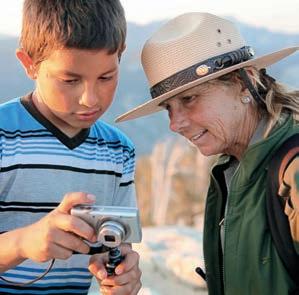

Wildlife teams surveyed mountains, wetlands and forests to observe animals in natural habitats. In Ackerson Meadow, they studied 1,220 songbirds, and documented rare owls, bats, reptiles and more.
YOSEMITECONSERVANCY.ORG 23 2017 ANNUAL REPORT
FINANCIAL STATEMENTS
of Dec. 31,
24 AUTUMN.WINTER 2018
Support & Revenue $16,558,360 Contributions $13,938,810 Retail & Publishing $1,327,229 Visitor Services & Programs $837,327 Investment Income & Other Revenue $454,994 Individuals $11,272,151 Cause-Related $1,331,716 Corporations $745,441 Events $174,562 Foundations $414,940 5% 8% 84% 3% *Reserves are maintained to meet future grant obligations to Yosemite National Park. ASSETS Current Assets Cash & Investments $14,003,555 Pledges, Receivables & Other Assets $2,826,537 Total Current Assets $16,830,092 Pledges Receivable, Net of Current Portion $658,661 Deposits $14,500 Land Held for Future Use $764,200 Charitable Remainder Trust, Net $350,250 Charitable Gift Annuities $133,516 Property & Equipment, Net $568,544 Total Noncurrent Assets $2,489,671 TOTAL ASSETS $19,319,763 LIABILITIES Current Liabilities Accounts Payable & Accrued Expenses $570,969 Grants Payable to Yosemite National Park $1,154,298 Total Current Liabilities $1,725,267 NET ASSETS Unrestricted* $12,483,228 Temporarily Restricted $4,097,559 Permanently Restricted $1,013,709 Total Net Assets $17,594,496 TOTAL LIABILITIES & NET ASSETS $19,319,763 2017 ANNUAL REPORT
Statement of Financial Position As
2017
YOSEMITECONSERVANCY.ORG 25 Dec. 31, 2017 Statement of Activities As of Dec. 31, 2017 Park Enhancements $7,222,224 Aid to Yosemite National Park $10,687,792 Visitor Services & Programs $2,324,776 Wildlife Management $441,589 Grant Administration $1,509,235 Visitor Services & Education $730,237 Other Pass-Thru Gifts & Grants $1,224,961 Cultural & Historic $183,611 Trail Repair & Access $692,506 Mariposa Grove Campaign $1,442,747 Habitat Restoration $820,936 Scientific Research $176,402 Retail & Publishing $1,140,792 10% 22% 68% SUPPORT & REVENUE Contributions $13,938,810 Retail & Publishing $1,327,229 Visitor Services & Programs $837,327 Investment Income & Other Revenue $454,994 TOTAL SUPPORT & REVENUE $16,558,360 FUNCTIONAL EXPENSES Program Services Park Enhancements $7,222,224 Retail & Publishing $1,140,792 Visitor Services & Programs $2,324,776 Total Aid to Park $10,687,792 Support Services Administrative $1,001,710 Fundraising $2,160,220 TOTAL EXPENSES
CHANGE IN NET ASSETS
NET ASSETS Beginning of Year $14,885,858 End of Year $17,594,496 2017 ANNUAL REPORT
$13,849,722
$2,708,638
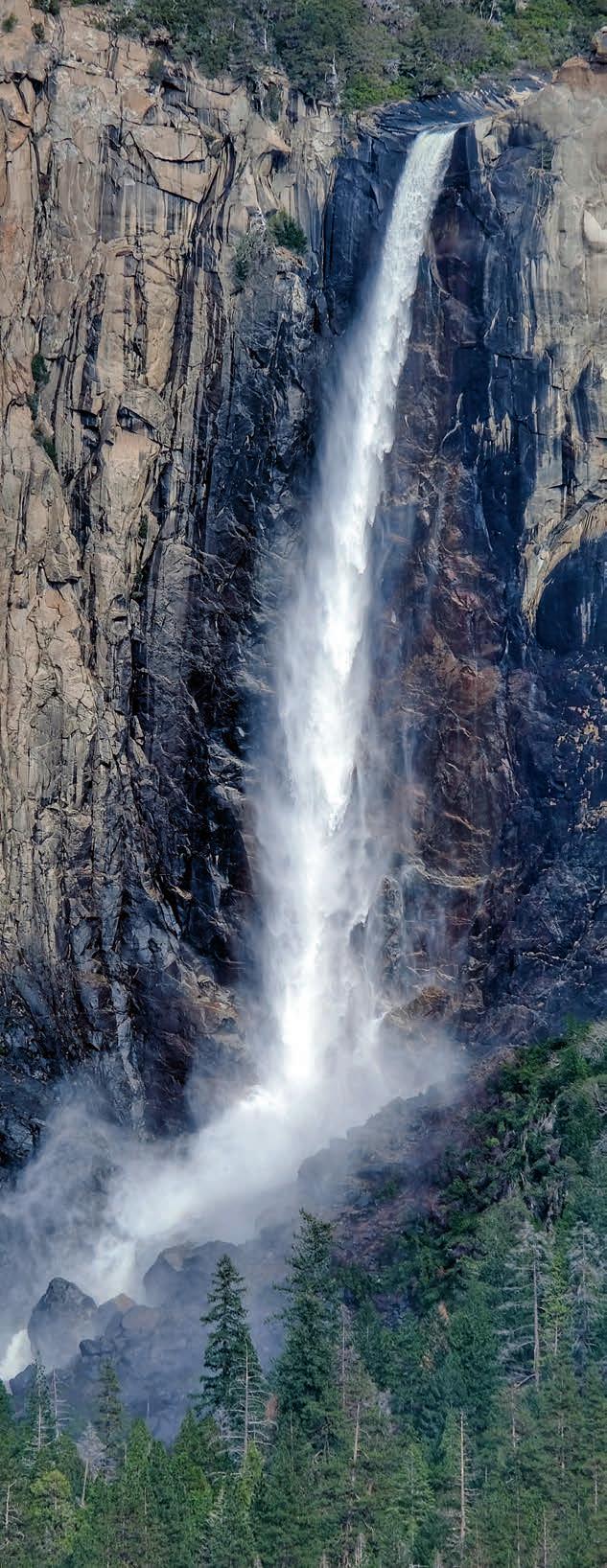

Yosemite Roots
Giving back to a girlhood home
t age 11, Jane Lundin moved to Yosemite Valley, where her grandmother was working as the principal and upper grades teacher of the park’s two-room schoolhouse.
She spent her adolescence going to school, learning to ride a bike and play the piano, and reading in her spare time. But she also regularly hiked and swam in one of the world’s most renowned natural landscapes by day, and folk-danced with WWII sailors staying at The Ahwahnee, temporarily transformed into a naval hospital, by night.
Jane eventually moved away from the park, but she stayed in touch with her teenage home. She and her husband, Robert, frequently took their two daughters on camping trips to Yosemite, and they supported the park with gifts to the Conservancy in ensuing decades.
In 2017, shortly after Robert passed away, Jane made a generous donation in his memory to support the restoration of Bridalveil Fall. When that project is complete, their names will appear on a bronze plaque near the famous waterfall, as an enduring reminder of their shared love for Yosemite.
PHOTOS: (TOP) © JANE LUNDIN. (LEFT) © JOHN MILAM.
ABOVE Conservancy supporter Jane Lundin fondly recalls her teenage years in Yosemite, including festive evening dances with WWII sailors staying at The Ahwahnee. LEFT In memory of her husband, with whom she shared many Yosemite adventures, Lundin made a generous gift to support a major restoration project focused on one of the park’s most famous features: Bridalveil Fall.

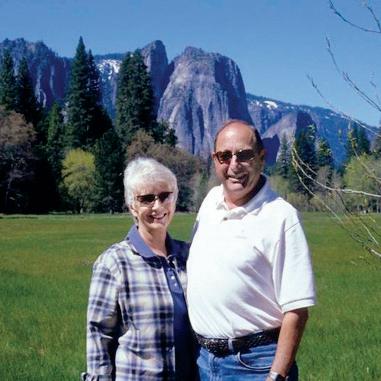
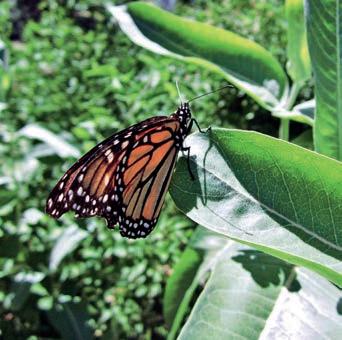
Protecting Their “Backyard” Park
A shared life of loving and supporting Yosemite
ne night, Jack and Sheri Overall were camped out near Yosemite Falls. They slept out in the open, with no tent blocking the cool night air or the stars gleaming overhead. Jack awoke to the sounds of pots banging nearby — and to the feeling of heavy breath on his face. He opened his eyes and met those of a curious black bear.
For some, that encounter might have put a damper on Yosemite, but for the Overalls, it’s just one more episode in a long string of beloved memories of the park, which they visited in all seasons to hike and camp in the early years of their marriage.
Now retired, Jack and Sheri retain a close connection to Yosemite. Since their first donation in the early 1980s, they have remained stalwart supporters of the park. Today, as John Muir Heritage Society donors, they make generous gifts to help preserve Yosemite’s beauty and natural resources, ensuring the place they fell in love with decades ago can continue to flourish.
YOSEMITECONSERVANCY.ORG 27 WHY I GIVE
ABOVE The Overalls have supported many projects in Yosemite over the years, including efforts to improve habitat for monarch butterflies and other pollinators.
PHOTOS: (TOP) © MICHAEL WHITE. (MIDDLE) © JACK & SHERI OVERALL. (BOTTOM) © YOSEMITE CONSERVANCY/REBECCA LINDSTROM.
ABOVE Inspired by their deep-rooted love for Yosemite’s natural beauty, the Overalls have supported projects to restore and preserve classic vistas in the park.
ANYWHERE THAT IS WILD


n the spring of 1868, a young John Muir first visited California, arriving by sea in San Francisco. In search of the quickest way out of town, the budding naturalist’s destination was “anywhere that is wild.” He started walking and did not turn back until he had experienced the wonders of Yosemite.
The compelling story of that historic journey is one prolific Muir never wrote out in its entirety. Inspired by Muir’s legacy as a naturalist, conservationist and adventurer, authors Peter and Donna Thomas have compiled this account of the trip, based on John Muir’s personal correspondence and published articles. This unique offering was published by Yosemite Conservancy to honor the 150th anniversary of Muir’s historic journey. Visit a Yosemite Conservancy bookstore, or shop online, to pick up your copy, and enjoy this warm, personal and entertaining look at a beautiful part of California through Muir’s eyes.
Proceeds from this book, and from all Yosemite Conservancy retail items, support important work in the park. To purchase, visit one of our bookstores in Yosemite, or shop online at yosemiteconservancy.org/shop.
28 AUTUMN.WINTER 2018
PUBLISHING
JOHN MUIR’S FIRST WALK TO YOSEMITE
Introducing Waterfall Weekend 2019
APRIL 5–7, 2019
All John Muir Heritage Society members are invited to join us to celebrate the magnificence of spring in Yosemite and the renewal of the famed waterfalls that cascade into the Valley.
Waterfall Weekend participants will enjoy three days filled with Yosemite activities, starting with a welcome reception at the Majestic Yosemite Hotel on Friday evening. Saturday begins with special presentations by National Park Service specialists and Yosemite Conservancy leadership, followed by midday outdoor exploration, and a private reception and dinner at The Majestic Yosemite Hotel. Sunday concludes with a naturalist-led stroll in Yosemite Valley.
For more information, please contact Kelda McKinney at kmckinney@yosemiteconservancy.org or 415-434-8446 x329.

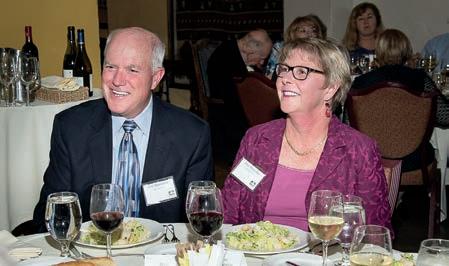




YOSEMITECONSERVANCY.ORG 29
Meet National Park Service leadership.
Gather with other members of the John Muir Heritage Society.
Learn about the impact of your support.
Walk through Yosemite Valley with expert naturalists.
Enjoy dinner at The Majestic Yosemite Hotel.
DONOR EVENTS
Marvel at the many waterfalls throughout the Valley.
PHOTO: (OPPOSITE) © MICHAEL WHITE.

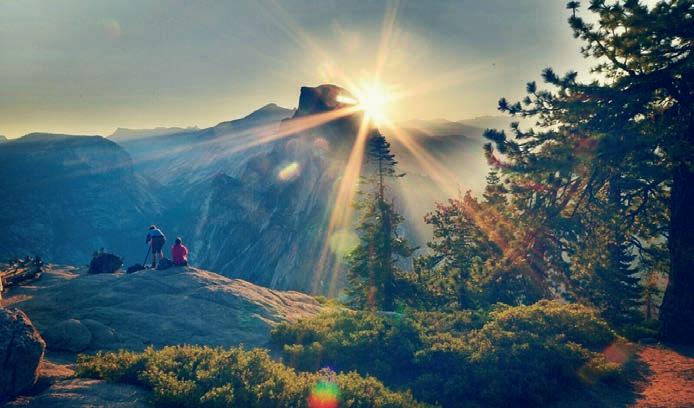


READER PHOTOS 30 AUTUMN.WINTER 2018 04 03 02 01 Morning Reflections PHOTO BY © DOUGLAS CROFT. 02 Yosemite Deer PHOTO BY © AMPARO B. 03 Yosemite Valley PHOTO BY © SARAH SOTO. 04 Half Dome PHOTO BY © JOE B. Show us your Yosemite photos! These images were captured by Yosemite fans like you. We’re always looking for photos to feature in our social media, enewsletter and magazine — and we’d love to see your shots! Share your favorites with us on Flickr, Facebook and Instagram, or email them to community@yosemiteconservancy.org. YOSEMITE’S MAJESTY AS CAPTURED BY OUR SUPPORTERS YOSEMITE THROUGH YOUR LENS 01
YOSEMITE CONSERVANCY
Magazine of Yosemite Conservancy, published twice a year.
EDITORIAL DIRECTOR
Jennifer Miller
MANAGING EDITOR
Alexa Schneier
CONTRIBUTING WRITERS
Frank Dean Alexa Schneier
Gretchen Roecker
DESIGN PRINT PRODUCTION
Eric Ball Design TradeMark Graphics, Inc.
STAFF :: San Francisco
Frank Dean, President & CEO
Jerry Edelbrock, Vice President, CFO & COO
Caitlin Allard, Major Gifts Officer – Northern California
Marion Ingersoll, Development Director
Alison Dombroski, Campaign & Development Projects Manager
Edin Draper-Beard, Executive Affairs Manager
Laura Garland, Senior Accountant
Kevin Gay, Finance Director
Debra Holcomb, Planned Giving & Data Services Director
Laurie Peterson, Institutional Giving Officer
Pongphat Kimpol, Data Services Assistant
Holly Kuehn, Development & Donor Services Assistant
Eryn Ligon, Data Services Analyst
Isabelle Luebbers, Annual Giving Director
Kelda McKinney, Events Manager
Jennifer Miller, Marketing & Communications Director
Gretchen Roecker, Communications & Social Media Manager
Alexa Schneier, Communications & Website Manager
STAFF :: Yosemite
Adonia Ripple, Director of Yosemite Operations
Kristen Anderson, Art Programs Manager
Greg Archer, Retail Accounting Coordinator
Nicole Brocchini, Museum Store Supervisor
Kylie Chappell, Outdoor Programs Manager
Katie Coit, Retail Operations Manager
Pete Devine, Resident Naturalist
Teresa Ellis, Sales Information Assistant
Schuyler Greenleaf, Projects Director
Cory Jacobs, Warehouse Coordinator
Ryan Kelly, Projects Manager
Olotumi Laizer, Valley Sales Supervisor
Mark Marschall, Volunteer Program Manager
Cassie May, Outreach Coordinator
Mark Scrimenti, Lead Wilderness Reservation Assistant
Madison Smith, Retail & Wholesale Coordinator
Laura Spielman, Art Center Assistant
Shelly Stephens, Inventory Manager
Laurie Stowe, Wilderness Programs Manager
STAFF :: Pasadena
Patti Johns Eisenberg, Senior Major Gifts Officer
– Southern California & National
Autumn.Winter 2018 :: Volume 09. Issue 02 ©2018
Federal Tax Identification No. 94-3058041
Ways to Give
THERE ARE MANY WAYS you and your organization can support the meaningful work of Yosemite Conservancy. We look forward to exploring these philanthropic opportunities with you.
CONTACT US
Visit yosemiteconservancy.org
Email info@yosemiteconservancy.org
Phone 415-434-1782
INDIVIDUAL GIVING
Development Director Marion Ingersoll mingersoll@yosemiteconservancy.org 415-434-8446 x324
Annual Giving
Isabelle Luebbers iluebbers@yosemiteconservancy.org 415-434-8446 x313
Major Gifts – Northern California Caitlin Allard callard@yosemiteconservancy.org 415-434-8446 x318
Major Gifts – Southern California Patti Johns Eisenberg peisenberg@yosemiteconservancy.org 626-390-1503
FOUNDATIONS & CORPORATIONS
Laurie Peterson lpeterson@yosemiteconservancy.org 415-434-8446 x328
PLANNED GIVING & BEQUESTS
Debra Holcomb dholcomb@yosemiteconservancy.org 415-434-8446 x319
Mail
Yosemite Conservancy 101 Montgomery Street, Suite 1700 San Francisco, CA 94104 Fax 415-434-0745
HONOR & MEMORIAL GIFTS
Isabelle Luebbers iluebbers@yosemiteconservancy.org 415-434-8446 x313
GIFTS OF STOCK
Eryn Ligon stock@yosemiteconservancy.org 415-434-8446 x330
SEQUOIA SOCIETY MONTHLY GIVING
Isabelle Luebbers iluebbers@yosemiteconservancy.org 415-434-8446 x313
MATCHING GIFTS
Isabelle Luebbers iluebbers@yosemiteconservancy.org 415-434-8446 x313
VOLUNTEER OPPORTUNITIES
Mark Marschall mmarschall@yosemiteconservancy.org 209-379-2317 yosemiteconservancy.org/volunteer
DONOR GUIDE YOSEMITECONSERVANCY.ORG 31
Yosemite Conservancy
101 Montgomery Street, Suite 1700
San Francisco, CA 94104

Your Yosemite Legacy
Honor the park that is close to your heart with a legacy gift to Yosemite Conservancy, and help protect this special place for generations to come.
Naming Yosemite Conservancy in your estate plan ensures the park remains wellpreserved and accessible for future visitors. Your gift will become part of the legacy fund, which improves the park and makes meaningful work possible.
To find out how you can leave a legacy to Yosemite, contact Debra Holcomb at dholcomb@yosemiteconservancy.org or 415-434-8446 x319. yosemiteconservancy.org/plannedgiving
Follow the Conservancy on social media to stay in touch on the go.
© YOSEMITE CONSERVANCY/KEITH WALKLET.
PHOTO:


















































 Bob Bennit, Chair Frank Dean, President
Bob Bennit, Chair Frank Dean, President






















